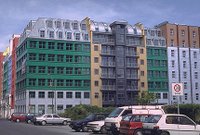 Aldo Rossi,(1931-1997) an unforgettable architect on symbolism, associated with the Italian Neo-Rationalist who won the the pritzker's prize in 1990. In 1992 he was given the 1991 thomas jefferson medal in architecture as well as the "campione d'italia" nel mondo prize. He was the nominated honourary member of the american academy of arts and letters of new york and in 1997. He also received the 1996 cultura prize for the architecture and design sector. Aldo Rossi died the 4th of september in milan the same year. to find out more...
Aldo Rossi,(1931-1997) an unforgettable architect on symbolism, associated with the Italian Neo-Rationalist who won the the pritzker's prize in 1990. In 1992 he was given the 1991 thomas jefferson medal in architecture as well as the "campione d'italia" nel mondo prize. He was the nominated honourary member of the american academy of arts and letters of new york and in 1997. He also received the 1996 cultura prize for the architecture and design sector. Aldo Rossi died the 4th of september in milan the same year. to find out more..."This understanding of the city and its element, its monuments, and its permanences, informed Aldo Rossi 's own designs for public buildings. One of his earliest major public buildings was the addition to the existing cemetery of the city of Modena in northern Italy. Perceiving the cemetery as a repository of social meaning, Aldo Rossi conceived of it as a house for the dead, indeed, a city of the dead. The elemental architectonic forms, as in the elegant stereometrie volumes of the ossuary with its chamfered windows, reflect his ongoing investigations into building typology, that which remains beyond the particular and the concrete." [1] to find out more...
"Ty`pol`ogy (ti pal e je) n. {TYPO- + -LOGY} 1 the study of types, symbols, or symbolism 2 symbolic meaning or representation; symbolism.
De`sign (di zin') -n. {Fr dessein <>typology is an analytical process, a means of separating the history of architecture (designs or theories) into a system of classification such as genealogy and cosmology. Typology, however, bases its understanding of architecture on forms which are classified into types based on specific criteria. For Rossi it is the ideas of public and private, and rational design and place.[2]
...
Rossi defines architecture as designs (forms) which have persisted over time to become types. Those types constitute the history of the city or its memory, and the culture of the present. Functions vary over time but form remains. It is the desire for permanence that is so characteristic of his work. The history of the city is composed by those designs which persist over time to become types. This permanence of memory (meaning) in the city is based on two principles:
memory - Urban facts which are permanent; those which withstand the passage of time and eventually become monuments.
monuments - These give meaning to the life of the city through memory. [3]
"Change is within the very destiny of things, for there is a singular inevitability about evolution ...The singular authority of the built object and the landscape is that of a permanence beyond people."[4]
Following the ideas set down in Architecture of the City, we can see how Rossi's architecture becomes one of re-presentation or a typological design which seeks permanence. He wrote "All this allows for a representation of the past with a desire for the present. [For] the past of a man in whom desire is dead ...the past paradoxically glows with the color of the future, with those of hope."[5] So, for Rossi, it is not a lament of the past which he desires, but a recovery of it in the present which establishes continuity within the history of the city."
[2] to find out more...
Thanks to PushPull forum ; located some useful links as listed below: -
- Biography Link
- Pritzker Prize webpage
- Wikipedia Link on Rossi
- Article from Metropolis magizine on Rossi
- Teatro del Mondo
- The Bonnefanten Museum
- Ide Virtual Design Museum
- Arc space
- Newspaper area complex - Berlin
- arBITAT
- Designers
- Orange Skin
- A thesis on Aldo Rossi by Jeremy John Beaudry
Image located from http://www.galinsky.com/buildings/newspaperarea/index.htm
[1] Passage from http://architect.architecture.sk/aldo-rossi-architect/aldo-rossi-architect.php
[2] Passage from http://www.uky.edu/Architecture/wakeup/issue4/aaron/welcome.htm
No comments:
Post a Comment